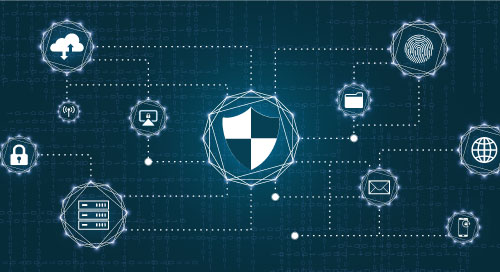Fill form to unlock content
Error - something went wrong!
Your content is just a step away. Please submit below.
Thank you!
SASE Solutions Enable Secure Digital Transformation

Businesses everywhere are experiencing the benefits of rapid digital transformation. But this change has given rise to new cybersecurity challenges.
“Organizations today have access to a rich ecosystem of cloud computing applications that boost productivity,” says Akarsh Jain, Product Marketing Manager at Sangfor Technologies, an IT infrastructure provider that specializes in cloud computing and network security. “However, this has blurred the physical boundaries of network security, resulting in coverage gaps and complicating secure access management.”
Similarly, mobile computing has made the modern workforce more agile and efficient. But this in turn has expanded the attack surface available to bad actors—and made it difficult and costly for defenders to guarantee cybersecurity using traditional solutions.
In the face of these challenges, cloud security providers like Sangfor have embraced a new approach: the secure access service edge (SASE). An SASE is a way to deliver core networking and cybersecurity capabilities as an integrated, cloud-native service. SASE solutions help IT and cybersecurity teams manage networking and access control in a secure way that is effective and scalable, while at the same time reducing costs and complexity.
SASE Solutions: Convergence of Networking and Security
Cloud providers like Sangfor offer their SASE as a holistic solution, making it tempting to consider SASE platforms as a single end-to-end solution rather than managing and integrating standalone software applications or security tools.
But it’s more helpful to think of SASE as an architectural approach that attempts to solve fundamental problems of networking, performance, and security in a cloud-based world.
“SASE delivers several key network and security technologies via the cloud, including software-defined wide-area networks (SD-WAN), secure web gateways (SWG), and firewall-as-a-service (FWaaS) applications,” says Jain. “They also make it easier for IT and security groups to adopt a zero-trust network access model of security—and enforce security policies consistently for all users and applications.”
This delivers a number of significant benefits to businesses. Use of SD-WAN reduces data backhaul and latency issues—improving overall network traffic efficiency and helping workers access their mission-critical data and applications without unnecessary delays. This is a tremendous operational advantage for businesses with multiple branches or a distributed workforce with remote users.
Beyond the modern software-defined networking capabilities it delivers, SASE also helps organizations protect sensitive data, mitigate cyber threats, and enforce security policies no matter where an employee is—or what device they’re using. SASE accomplishes this by bringing together several security technologies in a single service. For example, Sangfor’s SASE solution, Sangfor Access Secure, includes:
- Next-generation firewall (NGFW) to extend the protections of a traditional firewall solution with deep-packet inspection and a custom AI-enabled threat intelligence integration.
- Secure web gateway to filter web traffic and enforce internet security policies.
- Intrusion prevention system (IPS) that helps detect cyber threats in real time.
- Zero-trust network access model that guarantees secure remote access by requiring all users to verify themselves and their devices before they can access network resources.
The upshot is that SASE solutions allow companies to embrace digital transformation—SaaS and cloud-based tools, mobile computing, hybrid, and distributed workforces. At the same time, SASE ensures the same level of security that they enjoyed when data and applications were housed in secure data centers and employees worked in a central office behind the safety of the corporate firewall.
Next-Generation Hardware Improves SASE Performance
The engineering behind SASE solutions can be challenging, in part because they are a relatively new technology, and in part because they perform so many different functions.
But SASE developers are finding ways to take advantage of recent improvements to edge processors and associated technologies to make their solutions more effective and performant. Sangfor, for instance, bases its SASE offering on next-generation Intel hardware:
- 4th Generation Intel® Xeon® Scalable Processors form the basis of SASE’s distributed edge nodes and provide a stable and powerful processing platform for the solution.
- Intel® Advanced Matrix Extensions (Intel® AMX) accelerates the inferencing workloads required by SASE’s AI analytics and behavioral detection features.
- Intel® QuickAssist Technology (Intel® QAT) is used to speed encryption and compression workloads and improve overall performance of the solution.
- Intel® Software Guard Extensions (Intel® SGX) helps protect sensitive data even in highly distributed use cases.
Sangfor’s partnership with Intel has been instrumental in bringing its SASE solution to market. “Intel processors provide excellent performance and security,” says Jain. “They offer a powerful foundation for our SASE applications running at distributed edge topology points.”
Digital Transformation Without the Tradeoffs
SASE solutions are still a fairly new idea (even the term “SASE” was coined only in 2019), but they should see significant uptake in the future.
For one thing, almost every business is looking to foster digital transformation. SASE solutions make it possible to do that safely by alleviating secure network access issues and offering a better way to manage cybersecurity challenges of the modern workplace.
In addition, SASE helps eliminate complexity and reduce costs for IT teams. Multiple networking and security functions are managed through unified, cloud-based technology. There’s no longer any need to buy and deploy separate security equipment for each new branch office. It’s not necessary to juggle multiple security tools to accommodate different types of users in a hybrid office. And similar to other cloud-based services, enterprises can easily scale their SASE deployment up or down as business needs dictate.
“SASE represents a new model of network-security integration that is perfectly suited for our current age of digital transformation,” says Jain. “These solutions will deliver excellent value to all kinds of organizations over the coming years.”
This article was edited by Georganne Benesch, Editorial Director for insight.tech.